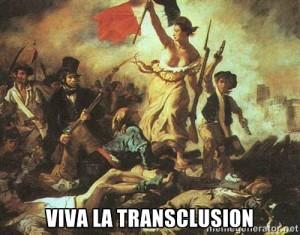
Over the past year Lumen has made great strides in promoting OER adoption, delivering OER and related services to thousands of students at dozens of institutions. However, we’ve struggled to find a highly scalable manner of doing so – for a very specific reason. We started out hosting our Open Course Frameworks in the Canvas learning management system because it’s both the best LMS out there (in my opinion) and is openly licensed. But over and over again we heard from faculty that they don’t want to send students out of their school’s official learning management system and into a second system from which OER are delivered, because this multiplicity of LMSs confuses students (and faculty). Instead, students and faculty want OER to be delivered within their institution’s learning management system. In order to meet this demand we spent much of the past year helping rebuild the same OER-based courses over and over again within several partner schools’ learning management systems. Obviously this process cannot scale to support thousands of schools and millions of students – which is the scale at which OER needs to operate in order to make a significant impact on the affordability and quality of education.
Beginning in January 2014 we launched a prototype of a new approach designed specifically to provide OER and related services to multiple schools in multiple learning management systems. In this new model, we host OER centrally and transclude it directly into multiple LMSs via the Learning Tools Interoperability (LTI) standard. With this transclusion technique, we’re able to host, manage, and improve courses in a single platform and make the content “magically” appear directly inside multiple schools’ learning management systems. The prototype is currently in use by multiple schools in multiple LMSs and has been extremely successful, providing us with a path to drastically improve our ability to scale the impact of OER by making them significantly easier to use.
So, for our Shuttleworth funded project we are going to create an openly licensed, high quality, highly scalable version of this functionality. What we’re calling the “Candela” platform will make OER easily usable in all LMSs (as well as environments supporting other learning world views, like PLE tools) that support LTI.
We’re building the Candela platform on top of WordPress, and expect that this will facilitate a huge number of synergies both anticipated and unanticipated. We’re already looking at integrating a few key tools and plugins that will drastically improve the end user experience – tools like Open Embeddable Assessments for in situ formative assessment and Hypothesis for highlighting and annotating. Types and Views look like promising ways to support CC licensing and inline attribution, as well as fine-grained alignment of OER with learning outcomes. And Candela will give us an excellent context for experimenting with the idea that learners should be able to own their learning content and learning data (full-course content export that preserves your notes and highlights, anyone?). And given all the energy and momentum in the open ed community around WordPress I can’t imagine what kinds of unforeseen random goodness will come in the future.
Finally, I’m super excited to announce that Lumen is working with FunnyMonkey on Candela development. I’ve been hoping for a chance to work with Bill for years now, and at last we have one.
Overall, I’m extremely excited about this work and the degree to which it will enable us to make OER easy for faculty to adopt and adapt and easy for students to learn from and own forever. I’d love to hear your feedback on our approach… Thoughts? What are we missing? How should we be working together?
hi David,
My take on this is that it sounds amazing. Please, let me get this straight: you are building a system (Candela) that will connect (for example) with our Moodle LMS & if users present content that’s stored on Candela it will automagically be updated within their course LMS as it gets updated at the central repository (i.e. on Candela)? Plus they’ll be able to access additional tools for formative assessment, annotation, attribution? This really *is* exciting & the only way I could be more excited is if I could understand the model a bit better. Could you provide a sort of ‘case study’ of how this would work from the user’s perspective & how Candela will work with the LMS? It sounds a bit as if Candela is an LMS on its own.
I would love to help facilitate this at IU. And can this work at the k12 level? I would really enjoy facilitating this! 🙂
This sounds very exciting (as a WordPress fan and an OER supporter). Will be keeping a close eye on this for application at my community college.